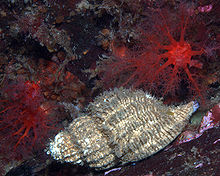- Fusitriton oregonensis
-
Oregon hairy triton 
Fusitriton oregonensis Scientific classification Kingdom: Animalia Phylum: Mollusca Class: Gastropoda (unranked): clade Caenogastropoda
clade Hypsogastropoda
clade LittorinimorphaSuperfamily: Tonnoidea Family: Ranellidae Subfamily: Ranellinae Genus: Fusitriton Species: F. oregonensis Binomial name Fusitriton oregonensis
Redfield, 1846The Oregon hairy triton, Fusitriton oregonensis, is a species of large predatory sea snail, a marine gastropod mollusk in the family Ranellidae, the tritons.
The snail was given its specific name oregonensis (meaning "of Oregon") to honor the Oregon Territory by conchologist John Howard Redfield in 1846.[1][2][3]
The Oregon hairy triton was declared the state seashell of Oregon in 1989 by the 65th Legislative Assembly.[4]
Contents
Distribution
The Oregon hairy triton is native to the northwestern coast of North America. The shells are found from Alaska to California, as well as in northern Japan. The shells often wash up on the coast during high tides.[1][2]
Shell description
The shells grow from three to five inches long.[5] The shell is light brown in color and is covered with gray-brown bristly periostracum, hence the name "hairy." The shell is an elongate cone with six whorls (or turns) around a central axis.
 Apertural view of a juvenile with operculum and contracted soft parts visible
Apertural view of a juvenile with operculum and contracted soft parts visible
Habitat
This species is common subtidally.[6]
Life habits
 Scanning electron microscopic image of immature parasperm lancet (infertile sperm morph) of Fusitriton oregonensis showing the tail brush still present, which later develops into part of the body of the parasperm. It is producing when sperm competition occurs.
Scanning electron microscopic image of immature parasperm lancet (infertile sperm morph) of Fusitriton oregonensis showing the tail brush still present, which later develops into part of the body of the parasperm. It is producing when sperm competition occurs.
Little is known of the snail's feeding habits, but they are believed to feed on other mollusks,[5] ascidians ("sea squirts"),[7] and more rarely, sea urchins.[8] The species also holds the record for longest larval development period of any marine invertebrate, able to delay metamorphosis for over 4 years until presented with appropriate habitat.[9] Under laboratory conditions, the larvae showed no signs of senescence at that point. According to some authorities, four years is long enough to drift completely across the Pacific Ocean.
References
- ^ a b State Symbols: Mushroom to Tree, Oregon Blue Book
- ^ a b "Fusitriton oregonensis". Gastropods.com. Archived from the original on 2007-09-27. http://web.archive.org/web/20070927020050/http://www.gastropods.com/3/Shell_1753.html. Retrieved 2007-08-16.
- ^ "Harvard University Index of Botanists". http://asaweb.huh.harvard.edu:8080/databases/botanists?id=102519. Retrieved 2007-08-16.
- ^ Chapter 186 — State Emblems; State Boundary 2005 Oregon Revised Statutes
- ^ a b "eNature: Oregon Hairy Triton". eNature. http://www.enature.com/fieldguides/detail.asp?shapeID=1095&curGroupID=9&lgfromWhere=&curPageNum=1. Retrieved 2007-08-16.
- ^ Washington State University Extension, Intertidal Organisms EZ-ID Guides: Fusitriton oregonensis (Oregon triton)
- ^ Young, C.M. (January 1985). "Abundance patterns of subtidal solitary ascidians in the San Juan Islands, Washington, as influenced by food preferences of the predatory snail Fusitriton oregonensis". Marine Biology 84 (3): 309–321. doi:10.1007/BF00392501. http://www.springerlink.com/content/r3p6227ut25pu08p/. Retrieved 2007-08-16.
- ^ Duggins, David O. (December 1983). "Starfish Predation and the Creation of Mosaic Patterns in a Kelp-Dominated Community". Ecology 64 (6): 1610–1619. doi:10.2307/1937514. JSTOR 1937514.
- ^ Strathmann, Megumi F.; Richard R. Strathmann (October 1, 2007). "An Extraordinarily Long Larval Duration of 4.5 Years from Hatching to Metamorphosis for Teleplanic Veligers of Fusitriton oregonensis". The Biological Bulletin 213 (2): 152–159. doi:10.2307/25066631. JSTOR 25066631. PMID 17928522. http://www.biolbull.org/cgi/content/full/213/2/152. Retrieved 2009-05-04.
Categories:- Ranellidae
- Western North American coastal fauna
- State shells of the United States
- Symbols of Oregon
Wikimedia Foundation. 2010.

